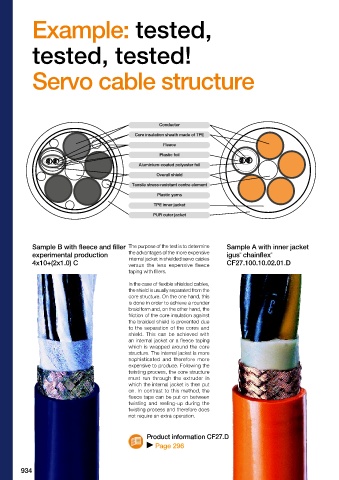Page 940 - ASEAN Chainflex Catalogue 2023
P. 940
Example: tested, Comparison between the igus
®
solution with the gusset-filling
tested, tested! internal jacket and the fleece
version with fillers
Servo cable structure Here, the servo cables are highly flexible motor cables with
a complete copper shield and an integrated, shielded pair
of control cores. This cable type was selected due to the
fact that the structure is not axisymmetric due to the different
core cross sections, and therefore emphasises the bending
behaviours of the different production methods.
Sample A: CF27.100.10.02.01.D (igus GmbH)
®
(4x10mm ) + (2x1.0mm )
2
2
Conductor
Sample B: experimental
Core insulation sheath made of TPE (4x10mm ) + (2x1.0mm )
2
2
Fleece
Both cables are provided with identical nominal cross sections
Plastic foil and insulation materials. Cable A is equipped with an internal
lll lll
lll lll llll llll jacket and cable B with a fleece taping and fillers.
llll
llll
llll llll llll llll
llll
llll
llll llll llll llll ll
ll
llll ll llll ll Aluminium-coated polyester foil
The experimental production (sample B) shows the formation
Overall shield
of a corkscrew after just 145,000 double strokes. In the case
Tensile stress-resistant centre element of a cable, the so-called corkscrew refers to the wave-shaped
deformation like that seen in the picture of sample B.
Plastic yarns
TPE inner jacket In the case of cable A, the internal jacket fills up the gussets
and a round braided structure is created as a result, cable B
PUR outer jacket requires fillers in the gussets. Like the core, the fillers are made
of filbrated polyethylene. They are easy to compress and are
therefore don‘t offer much support. By contrast, the internal
jacket, which is made of TPE, and the cable A centre element
hold the cores in a defined position. The cores of cable B are
Sample B with fleece and filler The purpose of the test is to determine Sample A with inner jacket able to move about with no resistance. During the bending
experimental production the advantages of the more expensive igus chainflex ® process, cores can detach themselves from the braid structure
®
internal jacket in shielded servo cables
4x10+(2x1.0) C versus the less expensive fleece CF27.100.10.02.01.D and shift into the inner bend radius or outer radius. This results
in the corkscrew-type deformations that repeat themselves
taping with fillers. periodically along the length.
In the case of flexible shielded cables,
the shield is usually separated from the Assessment
core structure. On the one hand, this 5,000,000 5,000,000
is done in order to achieve a rounder Despite the extremely low bending factor of 4.76, no signs of
braid form and, on the other hand, the wear can be detected in sample A (CF27.100.10.02.01.D) even 4,000,000
friction of the core insulation against after 5 million double strokes. Sample B, on the other hand, 3,000,000
the braided shield is prevented due with its fillers and fleece taping, succumbs to a corkscrew 2,000,000
to the separation of the cores and formation after just 145,000 double strokes. Therefore, 1,000,000
shield. This can be achieved with the result justifies the extra expenditure of the cable Number of double strokes 750,000
an internal jacket or a fleece taping with the gusset-filling internal jacket. 500,000
which is wrapped around the core 250,000 145,000
structure. The internal jacket is more 100,000
sophisticated and therefore more 50,000
expensive to produce. Following the 0
twisting process, the core structure Sample B Sample A
must run through the extruder in
which the internal jacket is then put
on. In contrast to this method, the
fleece tape can be put on between
twisting and reeling-up during the
twisting process and therefore does
not require an extra operation. Sample A: CF27.100.10.02.01.D
Product information CF27.D
Page 296
Sample B: experimental production
934 935

